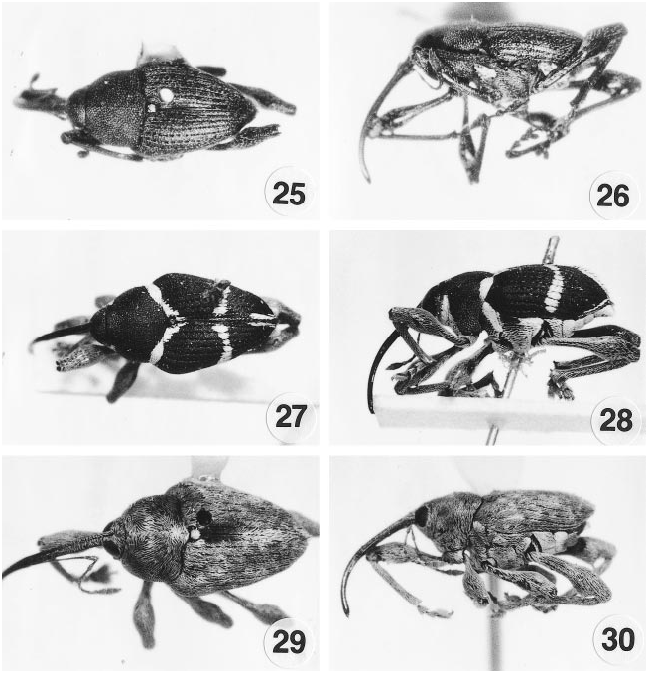Curculio ochromaculata Pelsue and Zhang
|
publication ID |
https://doi.org/10.1649/0010-065x(2000)054[0467:arotcf]2.0.co;2 |
|
DOI |
https://doi.org/10.5281/zenodo.15700376 |
|
persistent identifier |
https://treatment.plazi.org/id/8C170A27-B605-947A-FEB3-A73FFC7EFC3E |
|
treatment provided by |
Carolina |
|
scientific name |
Curculio ochromaculata Pelsue and Zhang |
| status |
sp. nov. |
Curculio ochromaculata Pelsue and Zhang View in CoL , New Species
Figs. 25–26 View Figs , 70–72 View Figs
HOLOTYPE. China. Xishuangbanna : male [China/ Yunnan /Xishuangbanna/ 21 April 1958 / 650 M/ F. Pu] ( IZAS)
PARATYPES. (1) male (2) females [ China / Yunnan / Xishuangbanna / 28 August 1958 /850 M/ Y. Zhang] ( FWPC)
Recognition Characters. Mediumsized, elongate oval, moderately robust; derm piceous; rostrum, 0.74 as long as body; frons broad, 0.28 as wide as head across eyes; hind femoral tooth largesized; hind femur with broad proximolateral sulcus, with deep punctures; vestiture of small, narrow, elongate, white scales; mesepimeron, first, second sternites, and prosternum, ventrad of rostrum with macula of broad, clavate, ochroleucus scales; hind femoral club dorsally angular, rather than evenly rounded.
Description. Male: Length: 5.2–5.7 mm (mean = 5.45). Width: 2.6–2.8 mm (mean = 2.7). Head: Moderately convex; moderately large punctures with small narrow, elongate, white scales; ventral macula of clavate, white scales; eyes large, oval, finely faceted; frons broad, 0.28 as wide as head across eyes; slitlike interocular fovea; punctures larger, with few small, narrow, elongate, white scales. Rostrum: Length: 4.0 mm, 0.74 as long as body; cylindrical; margins subparallel tapering to slightly expanded apex; almost straight to antennal insertion, thickened at base gradually tapering to apex, curved down abruptly after antennal insertion; indication of dorsal carina; lateral carinae above scrobe from frons to antennal insertion; glabrous from frons to apex; punctures oval, deep to antennal insertion, smaller, oval to apex; scrobe ventral; scape inserted in apical half. Antennae: Length: Scape 1.6–1.8 mm (mean = 1.7); Funiculus: segment one 0.50 mm, two 0.45 mm, three 0.25 mm, four 0.2 mm, five 0.25 mm, six 0.2 mm, seven 0.2 mm, club 0.6 mm; funicle 2.6 mm; scape 0.7 as long as funicle; derm of scape fuscous; funicle moderately clothed with narrow, elongate, dirty, white scales, with few erect setae toward apex of each segment; club elongate, oval, compact, acuminate; clothed with, short, velvety pile, longer than segments 4–7. Thorax: Length: 1.5–1.6 mm (mean = 1.55). Width: 2.1–2.2 mm (mean = 2.15). 0.73 as long as broad, with margins subparallel to midpoint, then angular to constriction, somewhat rounded; disc feebly convex laterally; median carina indistinct except at anterior margin; punctures large, shallow, with short, narrow, elongate, white scales; ventral macula between procoxal cavity of broad, clavate, white scales; base sinuate with moderate median declivity; mesosternal intercoxal process prominent, clothed with broad, clavate, and narrow, elongate, white scales; scutellum mediumsized, as long as broad, with small, narrow, elongate, white scales; mesepimeron densely clothed with broad, clavate, ochroleucus scales; mesepisternum with small, narrow, elongate, white scales; metepisternum clothed with smaller, broad, clavate, white scales, anterior margin with small, narrow, elongate, white scales; remainder of sternum with narrow, elongate, white scales; feeble indication of postocular lobe; procoxae clothed with narrow, elongate, white scales. Elytra: Length: 3.0– 3.3 mm (mean = 3.15). Striae deep with narrow, elongate, white scales; with scutellar declivity; humeri moderately prominent, angular and rounded; intervals broad, flat with 2 rows of narrow, elongate, white scales; without macula; crosshatched setae small. Legs: Length of hind femur 3.0– 3.1 mm (mean = 3.05), tooth largesized, wedge shaped, with acute apex, base with broad proximolateral sulcus, set with deep punctures extending to club; pro and mesofemoral tooth small; club of hind femur large, dorsal ridge angular, rather than rounded; all femora clothed with larger, narrow, elongate, white scales; hind tibial margins straight, subparallel; pro and mesouncus as long as tarsal claw; metauncus bifid; pad of third tarsal segment luteous. Abdomen: Sternite 1 longer than 2 behind coxal cavity, with broad median flat area; sternite 2 ascending to 3; sternite 3 longer than 4; sternite 5 as long as 3 and 4 combined; sternites 1 and 2 with lateral macula of broad, clavate, ochroleucus scales; remaining scales on all sternites small, narrow, elongate, white. Pygidium: Small ; clothed with elongate, ochroleucus, setalike scales. Genitalia: Median lobe of aedeagus 1.4 mm in length, 0.3 mm in width, evenly broad with thin margins narrowing abruptly to long spatula shaped apex ( Fig. 72 View Figs ), somewhat sinuate, rather thick, apex sharply arced in lateral view: apodeme 1.8 mm in length ( Figs. 70–72 View Figs ).
Distribution. China: Yunnan Province, Xishuangbanna, 21 April 1958, 650 M, F. Pu; 28 August 1958, 850 M, Y. Zhang.
Remarks. This species resembles C. shopfneri n. sp. and C. tonkinensis within the group, but can be separated by length and shape of rostrum, presence of mesepimeral macula, shape of femoral club and male genitalia.
| IZAS |
Institut Zoologii Akademii Nauk Ukraini - Institute of Zoology of the Academy of Sciences of Ukraine |
No known copyright restrictions apply. See Agosti, D., Egloff, W., 2009. Taxonomic information exchange and copyright: the Plazi approach. BMC Research Notes 2009, 2:53 for further explanation.
|
Kingdom |
|
|
Phylum |
|
|
Class |
|
|
Order |
|
|
Family |
|
|
Genus |


